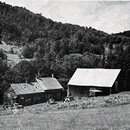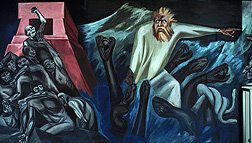MAIN SITES OF INTEREST

Four Wells
Eugen and Margrit Rosenstock-Huessy built Four Wells in 1937-8 with the proceeds of the sale of his library to the college; a list of the books sold [for the princely sum of $2,000] has just been found in the college archives. The house was named for the fact that it was only after digging three useless wells that they found enough water to sustain the household. The ground floor guest wing was paid for by their good friend Mary Taussig Henderson, who thought that they should have a guest room, and hoped to use it herself, as she did.
The house is substantially the same as it was on the day it was finished, with a few improvements made after Freya von Moltke came to live there; even many of the furnishings remain, including an enormous number of books and papers. Hans Huessy's room, with its own entrance door, is now part of a separate apartment. In 1985, Konrad von Moltke incorporated the barn into the home he built and connected to Four Wells. Anyone registered for this year's Roundtable is cordially invited to attend the "Eugen Party" at Four Wells at noon on Saturday, July 8th.
Hillside Cemetery
Margrit and Eugen Rosenstock-Huessy are buried in Hillside Cemetery in Norwich. The cemetery is on the map on the "parking" page [see sidebar], halfway between the "barn" and Four Wells, up Hillside Road off Hopson Road. Click on the "Hillside Cemetery" heading for a map. If you are going by car, please park outside and walk up and in, or bear in mind that the road within the cemetery is laid out for one-way traffic: traffic "up" should go straight at the gate, taking the SECOND left-hand turn and swinging around to the left to climb to the upper level; traffic "down" takes the direct route to the gate, but watch out for the speed bump.
The Rosenstock-Huessys are buried in the upper level, all the way over to the right-hand [north] edge of the cemetery along the stone wall under the pines, not far above the slope between the lower and upper levels. They lie near their friends, Walter and Lydia Behrendt, and a little further up the slope, Raymond and Margaret Gardner. Other "permanent residents" of Norwich with an ERH connection are: Hans R. Huessy, Alexander Laing, William Ballard, Willo and Konrad von Moltke, and Carl Deichmann.
Camp William James
 The original camp was held at the former CCC camp in Downer State Forest in Sharon, at what is now Downer 4-H Camp [click for a map]; the camp later moved to Tunbridge, VT. The current owners of the property replaced the farmhouse that housed CWJ recently, but have expressed a willingness, almost an eagerness, to welcome a visit Thursday or Friday afternoon. There is a move afoot to get the state to mark the location of both the Tunbridge and Sharon camps with historic markers; you are encouraged to contact John Dumville [john.dumville@state.vt.us] at the Vermont Division for Historic Preservation and let him know how important this is, especially if you come from Far Away.
The original camp was held at the former CCC camp in Downer State Forest in Sharon, at what is now Downer 4-H Camp [click for a map]; the camp later moved to Tunbridge, VT. The current owners of the property replaced the farmhouse that housed CWJ recently, but have expressed a willingness, almost an eagerness, to welcome a visit Thursday or Friday afternoon. There is a move afoot to get the state to mark the location of both the Tunbridge and Sharon camps with historic markers; you are encouraged to contact John Dumville [john.dumville@state.vt.us] at the Vermont Division for Historic Preservation and let him know how important this is, especially if you come from Far Away.Rauner Library at Webster Hall, Dartmouth College
 Dartmouth's Rauner Library is the deposit for the Rosenstock-Huessy papers; while most of what was given to the college in 1994 is still uncatalogued, there is a fair amount of material here, and the staff has been wonderful in helping me find internal Dartmouth documents on ERH, including a list of the books sold to finance the building of Four Wells.
Dartmouth's Rauner Library is the deposit for the Rosenstock-Huessy papers; while most of what was given to the college in 1994 is still uncatalogued, there is a fair amount of material here, and the staff has been wonderful in helping me find internal Dartmouth documents on ERH, including a list of the books sold to finance the building of Four Wells.[All Those from Far Away are encouraged to stop by and ask whether material they are interested in is available. This should NOT be construed as an invitation to harrassment; the Rauner librarian, Jay Satterfield, holds an ex officio seat on the ERH Fund Board, and the Rauner staff, as I said, is incredibly helpful. But it can't hurt for Dartmouth to know that the ERH world is in fact out there, and not just a handful of people who meet in Norwich twice a year.]
The Orozco Murals, Baker Library, Dartmouth College
 No visit to Rosenstock-Huessy's Dartmouth would be complete without a visit to the basement of Baker Library [visible, and immediately recognizable, from much of the surrounding area by its tall cupola] to see José Clemente Orozco's 24-panel mural on American Civilization. The final panel, Christ taking down the cross, is featured in Out of Revolution, and it is easy to see why ERH found the artwork a sign of the times.
No visit to Rosenstock-Huessy's Dartmouth would be complete without a visit to the basement of Baker Library [visible, and immediately recognizable, from much of the surrounding area by its tall cupola] to see José Clemente Orozco's 24-panel mural on American Civilization. The final panel, Christ taking down the cross, is featured in Out of Revolution, and it is easy to see why ERH found the artwork a sign of the times. The college, on the other hand, which had hired Orozco to teach students the art of fresco painting, wound up with a major crisis on its hands, as furious alumni chimed in to let President Hopkins know just how wrong he was to allow a Communist snake like Orozco a place at Dartmouth's table.
The college, on the other hand, which had hired Orozco to teach students the art of fresco painting, wound up with a major crisis on its hands, as furious alumni chimed in to let President Hopkins know just how wrong he was to allow a Communist snake like Orozco a place at Dartmouth's table.The controversy continued for years, and the story goes that it was a single professor of art who managed to prevent the entire series from being white-washed over, though the president's ongoing defense of Orozco makes the story unlikely.
A Love-Letter to Baker Library
In 1949 Alice Herdan-Zuckmayer, wife of the playwright Carl Zuckmayer, published a memoir of their years in the Vermont hills, which included a paean to the delights of a college library which in those bygone days was still open to any resident of the area.
The book grew out of the letters the author wrote her parents, who had stayed behind in Europe when the Zuckmayers and their two children fled Austria for the United States. After the war, Erich Kästner, editor of the Munich Neue Zeitung, saw the letters on a visit to her parents and began running them in the newspaper's magazine section, much to Herdan-Zuckmayer's astonishment. She then agreed to expand them into a book.
The book is well-known in Germany [the 1987 English edition, translated by Ida and Carol Washington, and published by the New England Press, reports with exclamation marks that 400,000 copies had been sold]. Click here to download the chapter on Baker Library.